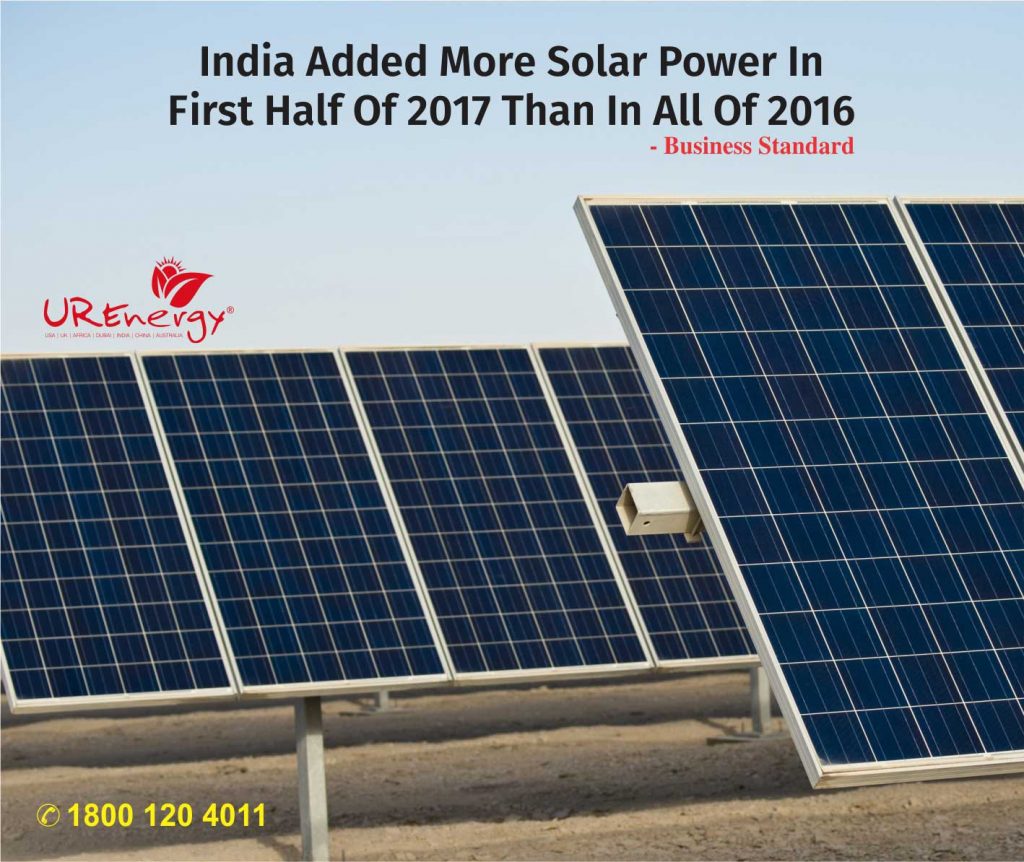Uncertainty over GST, utilities renegotiating to get better rates pose challenge for future addition

The Indian solar market added 1,869 megawatt (Mw) in the second quarter of 2017, bringing installations in the first half of the year to 4,765 Mw. This figure surpasses the 4,313 Mw installed in all of 2016.
Mercom India Research shows that in the first half of 2017, large-scale solar installations made up 4,290 Mw (90 per cent) and rooftop installations constituted 475 MW (10 per cent) of total installations. Cumulative solar rooftop installations crossed a significant milestone of 1 Gw at the end of Q2 2017.
The Indian solar market had its best first half and is on pace to have its best year, said Raj Prabhu, CEO and Co-founder of Mercom Capital Group.
However, uncertainty around Goods and Services Tax (GST) rates, utilities renegotiating to get better rates, and the recently initiated anti-dumping case has stalled momentum in the sector and could have a significant negative effect on installations in 2018, said Prabhu.
Andhra Pradesh became the first state in India to install over 2 Gw of solar power. Currently, seven states have exceeded 1 Gw of solar installations.
The pipeline of Indian utility-scale projects under construction is currently 12.2 Gw, with about 6.3 Gw of tenders pending to be auctioned.
Solar projects amounting to around 3.4 Gw were tendered in the second quarter of 2017, compared to 1.85 Gw in the first quarter this year. There were 2.5 Gw of solar projects auctioned in Q2 2017, compared to 1.3 Gw in Q1 2017.
The lowest bid in solar reverse auctions declined significantly by about 26 per cent from the first quarter to the second quarter of 2017 and average large-scale solar project costs in Q2 2017 were approximately Rs 4 crore ($0.62 million) per Mw.
The research firm forecasts 2017 installations to reach 10.5 Gw, which would be a 144 per cent increase year-over-year compared to the 4.3 Gw installed last year.
While the GST rates applicable to the sector have been announced, there is still a lot of confusion and ambiguity surrounding them. Initially, a rate of five per cent was announced for all solar components, which was then clarified to be five per cent only for solar modules and 18 per cent or more for other components.
The second quarter also saw the lowest ever tariff of Rs 2.44 ($0.037)/kWh in the recently conducted 500-Mw Bhadla Phase-III Solar Park auction. Most utilities now want a similarly low tariff, which has led to delays in power purchase agreement signings, tenders, and auctions.
“Most projects under construction will not be affected, but new tender and auction activity has stalled and most developers are taking a pessimistic view of the recent developments,” said Priya Sanjay, managing director of Mercom Communications India.
While power distribution companies are looking for the lowest tariff, the anti-dumping petition filed by domestic manufacturers against solar imports from China, Taiwan, and Malaysia with the Directorate General of Anti-Dumping (DGAD) has been accepted. DGAD has officially initiated the investigation with the possibility of preliminary findings in as soon as two months.
Chinese module prices in India fell by about five per cent in the second quarter of 2017. As expected, module prices firmed up in June due to high demand in China before its feed-in tariff cuts at the end of June.
Chinese module prices are falling less dramatically than in Q3 2016 because the 5.5 Gw top-runner programme and poverty alleviation programme are keeping demand steady.
Meanwhile, developers in the US are looking to procure Chinese panels in anticipation of anti-dumping tariffs in the Suniva case. This presents a challenging scenario for Indian developers who are bidding lower and lower while anticipating that Chinese module prices will continue to decline indefinitely, said Sanjay.
Source By : Business Standard



next year two month enough to achieve entire year this year installation